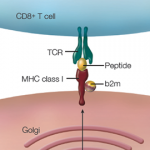Another tool allowed them to make note of functional similarities among the genes whose activity was altered by Takayasu arteritis-associated variants. “What do these genes have in common? What pathways? What cell types are enriched within these genes that induces susceptibility to Takayasu?” Dr. Sawalha asks. “By knowing that, we know what pathways in the immune system might be involved in the disease pathogenesis and also what pathways we can target for therapy.”
Yet another analysis let the researchers explore disease-associated epigenetic changes, or physical modifications to the DNA structure that alter a gene’s activity without actually changing its DNA sequence. About 90% of the Takayasu arteritis-linked variants are enriched in these epigenetic changes, he notes, bolstering the idea that they may play regulatory roles.
The DNA-protein complex, called chromatin, that makes up human chromosomes can also mediate physical changes by forming large loops, allowing some regulatory regions to interact with and control genes that would otherwise be far away. In Takayasu arteritis, Dr. Sawalha says, emerging evidence suggests at least two disease-associated loci may use this regulatory strategy to alter the activity of distant genes, including the promoter of the ETS2 gene, previously identified as a key regulator of inflammation in macrophage immune cells. By studying which genes are being controlled in this way, the researchers can glean further clues about how they may relate to disease processes and whether they might represent potential therapeutic targets.
Finally, the researchers found that members of at least two big families of transcription factors, or proteins that control how and when genes are turned off and on, were significantly more enriched in Takayasu arteritis-associated genetic sites than in other random sites on the genome. These specific transcription factors, part of the STAT and RUNX families, are known to help regulate immune functions and inflammatory responses. What the new research finding means, Dr. Sawalha says, is that these transcription factors may play a role in Takayasu arteritis as well, and thus offer additional therapeutic targets.
The growing list of functional pathways, transcription factors and causal genes can help the researchers piece together a better understanding of the cellular functions and cell types involved in the disease. The next step, Dr. Sawalha says, is to experimentally determine whether and how the associated genetic variants are pathogenic to cell cultures grown in vitro. He and colleagues are also conducting high-throughput analyses to narrow down the SNPs that merit further study.

